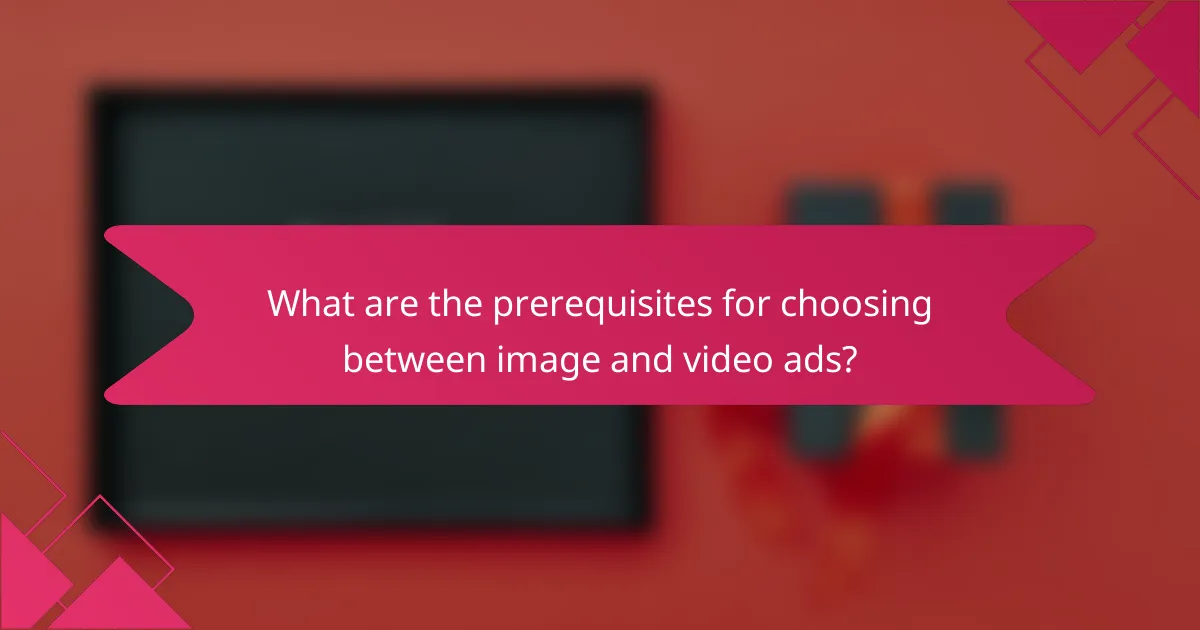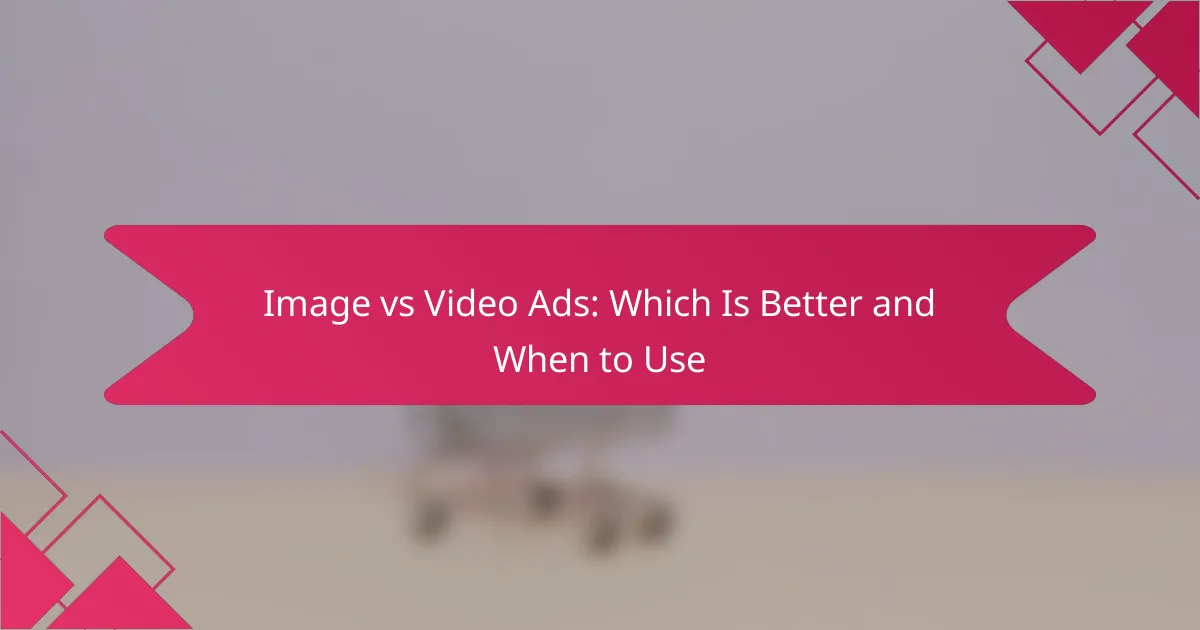In the realm of digital marketing, both image and video ads serve distinct purposes, with their effectiveness hinging on specific campaign objectives and target demographics. Image ads are ideal for quick messaging and immediate engagement, while video ads excel at delivering compelling narratives and showcasing products in action. Understanding when to leverage each format can significantly enhance a brand’s marketing strategy.

Which ad format is more effective in digital marketing?
Both image and video ads have their strengths in digital marketing, but their effectiveness largely depends on the campaign goals and target audience. Image ads typically excel in generating quick clicks, while video ads are better suited for conveying deeper brand narratives.
Image ads drive higher click-through rates
Image ads often achieve higher click-through rates (CTR) compared to video ads, especially in campaigns focused on direct response. Their simplicity allows for quick consumption, making them ideal for capturing immediate interest.
For instance, a well-designed banner ad can attract attention in seconds, leading to faster user actions. Marketers should consider using bold visuals and concise messaging to maximize CTR in image ads.
Video ads enhance brand storytelling
Video ads are powerful tools for brand storytelling, allowing marketers to engage audiences emotionally. They can convey complex messages and showcase products in action, which is often more compelling than static images.
For example, a short video demonstrating a product’s features can create a narrative that resonates with viewers, leading to stronger brand recall. Brands should aim for high-quality production and authentic storytelling to leverage the full potential of video ads.
Image ads are cost-effective for small budgets
Image ads are generally more cost-effective than video ads, making them suitable for businesses with limited marketing budgets. They require less investment in production and can be easily created with graphic design tools.
Small businesses can benefit from using image ads on platforms like social media or Google Display Network, where costs can be managed effectively. Prioritizing clear visuals and targeted placements can yield good returns without overspending.
Video ads increase engagement on social media
Video ads tend to generate higher engagement rates on social media platforms compared to image ads. Users are more likely to interact with video content, leading to shares, comments, and likes, which can amplify reach organically.
For effective social media campaigns, brands should create short, engaging videos tailored to the platform’s audience. Utilizing features like captions and calls to action can further enhance viewer interaction and retention.

When should businesses use image ads?
Businesses should use image ads when they want to convey a message quickly and effectively. These ads are particularly useful for capturing attention and driving immediate responses, especially in digital marketing campaigns.
Best for quick promotions and sales
Image ads excel in scenarios where swift promotions or sales are necessary. They can quickly showcase a product or service, often leading to immediate consumer action. For example, a retailer might use an eye-catching image ad to promote a limited-time discount, encouraging potential customers to make a purchase.
To maximize effectiveness, ensure the visuals are striking and the call-to-action is clear. Using bold colors and concise text can help grab attention and drive conversions during flash sales or seasonal promotions.
Ideal for targeting specific demographics
Image ads are particularly effective for reaching specific demographic groups. By tailoring visuals and messaging to resonate with a particular audience, businesses can enhance engagement and relevance. For instance, a brand targeting young adults might use trendy designs and relatable themes in their image ads.
Consider using demographic data to inform your image ad strategy. This could include age, gender, or interests, allowing you to create ads that speak directly to the needs and preferences of your target market. Testing different images can also help identify what resonates best with your audience.

When should businesses use video ads?
Businesses should consider using video ads when they aim to engage audiences through dynamic storytelling or when showcasing products in action. Video ads are particularly effective for conveying complex messages and capturing attention in a crowded digital landscape.
Effective for product demonstrations
Video ads excel in demonstrating products, allowing potential customers to see them in action. This format helps clarify features and benefits that might be difficult to convey through images alone. For instance, a kitchen appliance can be shown in use, highlighting its ease of operation and effectiveness.
When creating product demonstration videos, aim for clarity and brevity. Keep videos under two minutes to maintain viewer interest, and focus on key functionalities that solve customer pain points. A well-structured demonstration can significantly enhance conversion rates.
Great for building emotional connections
Video ads are powerful tools for fostering emotional connections with audiences. By using storytelling techniques, businesses can evoke feelings that resonate with viewers, making them more likely to remember the brand. For example, a heartfelt narrative about a family using a product can create a lasting impression.
To maximize emotional impact, consider incorporating relatable characters and situations in your videos. Use music and visuals that align with your brand’s message to enhance the emotional experience. Aim for authenticity, as genuine stories often lead to stronger customer loyalty and engagement.

How do image and video ads compare in cost?
Image ads generally have lower production costs compared to video ads, making them a more budget-friendly option for many businesses. However, the choice between the two should consider not only initial expenses but also potential returns on investment.
Image ads typically have lower production costs
Creating image ads usually involves simpler processes, such as graphic design and photography, which can be done with relatively low budgets. Costs can range from a few hundred to a couple of thousand dollars, depending on the complexity and quality required.
For small businesses or startups, image ads can be an effective way to promote products or services without significant financial risk. Utilizing stock images or in-house design can further reduce expenses.
Video ads require higher investment but yield better ROI
Video ads typically demand a larger investment due to costs associated with scripting, filming, and editing. Production expenses can start in the low thousands and go up significantly based on the quality and length of the video.
Despite the higher upfront costs, video ads often deliver better returns on investment. They tend to engage viewers more effectively, leading to higher conversion rates. Businesses should weigh the initial costs against the potential for increased engagement and sales.

What are the prerequisites for choosing between image and video ads?
Choosing between image and video ads depends on several factors, including your target audience, campaign goals, and the platforms you plan to use. Understanding these prerequisites can help you make an informed decision that maximizes engagement and conversion rates.
Understanding target audience preferences
Knowing your target audience’s preferences is crucial when deciding between image and video ads. Younger demographics often prefer video content, while older audiences might respond better to static images. Conducting surveys or analyzing engagement metrics can provide insights into what formats resonate most with your audience.
Consider the platforms where your audience spends time. For instance, video ads perform well on social media platforms like Instagram and TikTok, while image ads might be more effective on platforms like Pinterest or LinkedIn. Tailoring your ad format to the platform can enhance visibility and engagement.
Assessing campaign goals and objectives
Your campaign goals significantly influence the choice between image and video ads. If your objective is to convey a complex message or tell a story, video ads are often more effective. They allow for dynamic storytelling and can capture attention for longer periods.
On the other hand, if your goal is to promote a specific product or service quickly, image ads can deliver a clear and concise message. They are typically quicker to produce and can be more cost-effective, especially for campaigns with tight budgets. Evaluate your objectives carefully to choose the format that aligns best with your desired outcomes.

What metrics should be used to evaluate ad performance?
To evaluate ad performance effectively, focus on metrics that directly reflect user engagement and conversion potential. Key metrics include click-through rates for image ads and view duration for video ads, as they provide insights into how well your ads capture attention and drive action.
Click-through rates for image ads
Click-through rate (CTR) measures the percentage of viewers who click on an image ad after seeing it. A higher CTR indicates that the ad is compelling and relevant to the audience. Generally, a CTR of 1-3% is considered average, while rates above 3% are seen as strong.
To improve CTR, ensure your image ads are visually appealing and include a clear call to action. Testing different designs and messaging can help identify what resonates best with your target audience. Avoid cluttered visuals, as they can detract from the main message.
View duration for video ads
View duration refers to the average time viewers spend watching a video ad. Longer view durations typically suggest that the content is engaging and holds the audience’s attention. Aim for a view duration that is at least 15-30 seconds for short ads, while longer formats may benefit from being 1-2 minutes.
To maximize view duration, create captivating content that hooks viewers in the first few seconds. Use storytelling techniques and maintain a clear focus throughout the video. Avoid overly long intros, as they can lead to viewer drop-off. Regularly analyze performance data to refine your video strategy based on audience preferences.

What are the emerging trends in ad formats?
Emerging trends in ad formats highlight a shift towards more engaging and interactive experiences. Advertisers are increasingly leveraging innovative formats, such as interactive video ads, to capture audience attention and drive conversions.
Increased use of interactive video ads
Interactive video ads allow viewers to engage with content in real-time, enhancing user experience and retention. These ads often include clickable elements, such as buttons or links, enabling users to explore products or services directly within the video.
Consider using interactive video ads when aiming to boost engagement and conversions. They can be particularly effective for product launches or promotional campaigns, where showcasing features through interaction can lead to higher interest and sales.
To implement interactive video ads successfully, focus on clear calls to action and ensure the interactive elements are intuitive. Avoid overwhelming users with too many options, as this can lead to confusion and disengagement.










